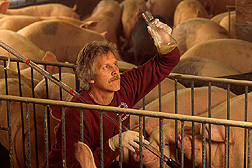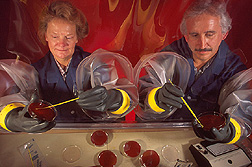Whence Come Hog Manure Odors?
|
|
 In a swine facility near Peoria, Illinois, microbiologist Terry Whitehead collects fresh manure samples for use in tests to identify bacteria that may be involved in odor production. (K8771-17) |
Researching the question "What makes manure stink?" is no ivory-tower pursuit for ARS microbiologist Michael A. Cotta and his colleagues. In their view, finding which microbes are responsible is a fundamental step toward helping the livestock industry improve production efficiency and live in harmony with their rural and urban neighbors. The scientists at the National Center for Agricultural Utilization Research in Peoria, Illinois, are focusing on bacteria that thrive in the lower digestive tract of swine and in waste handling facilities. These bacteria produce myriad odors from feed that's not fully digested. Once the researchers know which culprits produce the worst odors and how, animal nutritionists and agricultural engineers can work on the problem with new types of feed and new waste handling systems. |
|
 To isolate bacteria present in swine waste samples, microbiologists Rhonda Zeltwanger and Michael Cotta work in an anaerobic glove box. Because most of these bacteria are strict anaerobes, many manipulations must be performed in the absence of oxygen. (K8772-15) |
In swine waste, all too prevalent malodorous compounds include ammonia, organic acids, alcohols, and—the most offensive of all—sulfides. Some of the compounds can have bad health effects on animals and humans. For example, chronic exposure to air with high ammonia concentrations can harm the respiratory system. Microorganisms in waste storage pits and treatment lagoons thrive in such a vast array that just isolating significant numbers of specific ones was, until now, a tedious—even daunting—task. And that was just a first step toward identifying the microbes and the odors they generate. Taking a thorough census should soon be easier, using research tools like DNA sequence analysis, diagnostic probes, and a fluorimaging analysis, says Cotta. He, with microbiologist Terence R. Whitehead and postdoctoral microbiologist Cherie J. Ziemer, are developing a way to extract the DNA from all the microbes in a waste slurry sample and, in one fell swoop, detect and measure the prevalence of the many genera, species, and strains of the microorganisms. What causes the rise or fall of populations of microbes that are the real stinkers? To find answers, the scientists have taken waste samples from one farm that specializes in feeder pig production; now they're examining samples from other farms where swine of different ages are fed different feeds. "As we continue, we'll compare our data on microbes with the findings of our ARS colleagues at Ames, Iowa, who are analyzing odors from air samples near livestock operations," says Cotta (See "Measuring Odors From Livestock Operations," Agricultural Research, April 1998, p. 24.) So far, the researchers have found that the most common bacteria in fresh swine manure include those in the genera Clostridium, Lactobacillus, and Ruminococcus, while the most common in swine waste pits include a mix of Clostridium, Streptococcus, and Peptostreptococcus. Although the scientists are focusing on the pit storage environment, what they learn may be applied to research on manure that is composted or processed through lagoons. Soon the researchers will be cranking out large numbers of diagnostic probes to inventory microbes in manure samples from different environments. Such probes will zero in on certain microbial species that may be important odor producers though their populations may be somewhat small. Techniques developed in the research may be used to learn how well human pathogens and antibiotic-resistant microbes survive in stored manure. Microbes of particular interest are likely to include Escherichia coli and species of Salmonella.—By Ben Hardin, Agricultural Research Service Information Staff. This research is part of Manure and Byproduct Utilization, an ARS National Program (#206) described on the World Wide Web at http://www.nps.ars.usda.gov/programs/nrsas.htm. Michael A. Cotta, Terence R. Whitehead, and Cherie J. Ziemer are at the USDA-ARS National Center for Agricultural Utilization Research, 1815 N. University St., Peoria, IL 61604; phone (309) 681-6273, fax (309) 681-6686. |
|
"Whence Come Hog Manure Odors?" was published in the March 2000 issue of Agricultural Research magazine.
|
|






